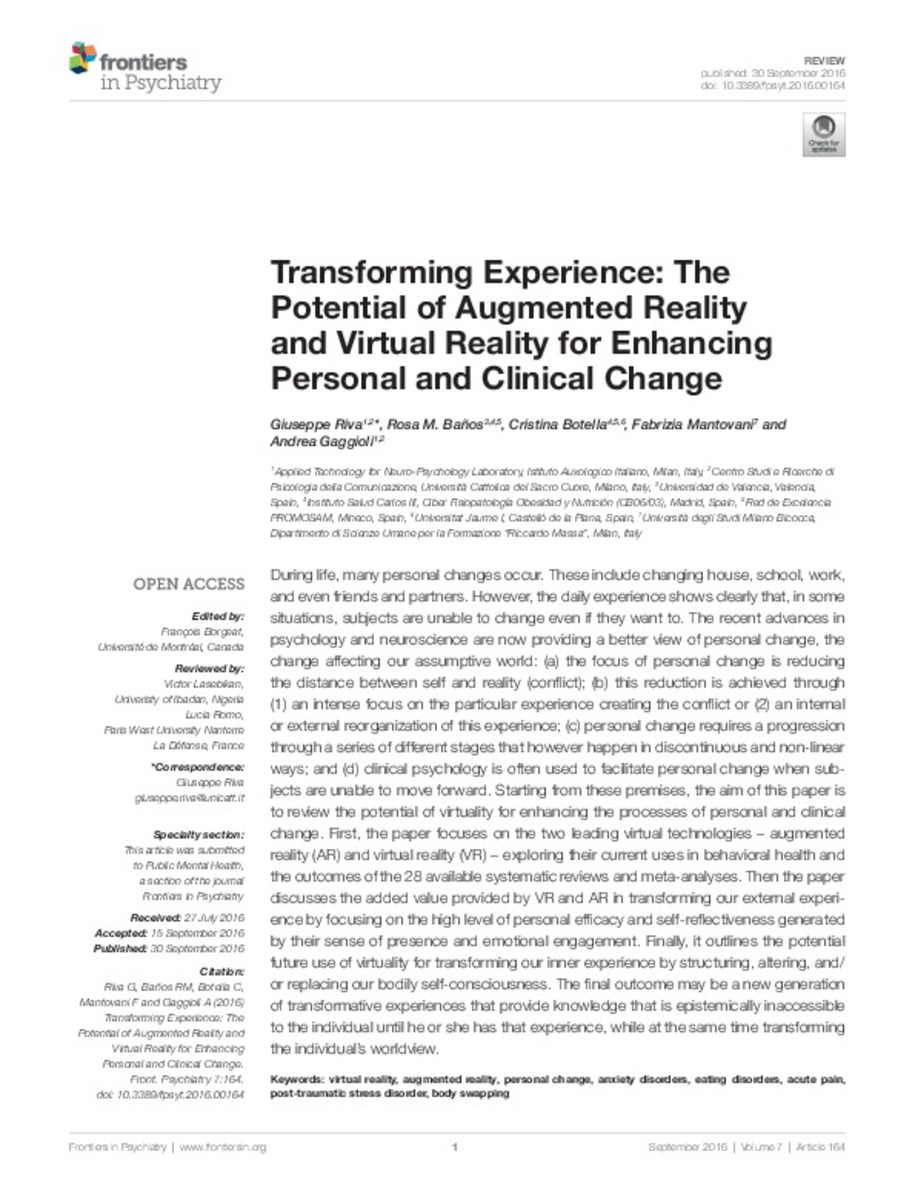Mostrar el registro sencillo del ítem
Transforming Experience: The Potential of Augmented Reality and Virtual Reality for Enhancing Personal and Clinical Change
| dc.contributor.author | Riva, Giuseppe | |
| dc.contributor.author | Baños, Rosa Maria | |
| dc.contributor.author | Botella, Cristina | |
| dc.contributor.author | Mantovani, Fabrizia | |
| dc.contributor.author | Gaggioli, Andrea | |
| dc.date.accessioned | 2017-01-17T08:23:55Z | |
| dc.date.available | 2017-01-17T08:23:55Z | |
| dc.date.issued | 2016-09 | |
| dc.identifier.citation | RIVA, Giuseppe, et al. Transforming experience: the potential of augmented reality and virtual reality for enhancing personal and clinical change. Frontiers in Psychiatry, 2016, vol. 7. | ca_CA |
| dc.identifier.uri | http://hdl.handle.net/10234/165364 | |
| dc.description.abstract | During life, many personal changes occur. These include changing house, school, work, and even friends and partners. However, the daily experience shows clearly that, in some situations, subjects are unable to change even if they want to. The recent advances in psychology and neuroscience are now providing a better view of personal change, the change affecting our assumptive world: (a) the focus of personal change is reducing the distance between self and reality (conflict); (b) this reduction is achieved through (1) an intense focus on the particular experience creating the conflict or (2) an internal or external reorganization of this experience; (c) personal change requires a progression through a series of different stages that however happen in discontinuous and non-linear ways; and (d) clinical psychology is often used to facilitate personal change when subjects are unable to move forward. Starting from these premises, the aim of this paper is to review the potential of virtuality for enhancing the processes of personal and clinical change. First, the paper focuses on the two leading virtual technologies – augmented reality (AR) and virtual reality (VR) – exploring their current uses in behavioral health and the outcomes of the 28 available systematic reviews and meta-analyses. Then the paper discusses the added value provided by VR and AR in transforming our external experience by focusing on the high level of personal efficacy and self-reflectiveness generated by their sense of presence and emotional engagement. Finally, it outlines the potential future use of virtuality for transforming our inner experience by structuring, altering, and/or replacing our bodily self-consciousness. The final outcome may be a new generation of transformative experiences that provide knowledge that is epistemically inaccessible to the individual until he or she has that experience, while at the same time transforming the individual’s worldview. | ca_CA |
| dc.description.sponsorShip | This paper was funded by the research project “Tecnologia Positiva e Healthy Ageing” funded by Università Cattolica del Sacro Cuore (D3.2, Ricerche di interesse d’Ateneo 2014). | ca_CA |
| dc.format.extent | 14 p. | ca_CA |
| dc.format.mimetype | application/pdf | ca_CA |
| dc.language.iso | eng | ca_CA |
| dc.publisher | Frontiers Media | ca_CA |
| dc.relation.isPartOf | Front Psychiatry. 2016; 7: 164. | ca_CA |
| dc.rights | Copyright © 2016 Riva, Baños, Botella, Mantovani and Gaggioli. | ca_CA |
| dc.rights | Atribución 4.0 España | * |
| dc.rights.uri | http://creativecommons.org/licenses/by-sa/4.0/ | * |
| dc.subject | virtual reality | ca_CA |
| dc.subject | augmented reality | ca_CA |
| dc.subject | personal change | ca_CA |
| dc.subject | anxiety disorders | ca_CA |
| dc.subject | eating disorders | ca_CA |
| dc.subject | acute pain | ca_CA |
| dc.subject | post-traumatic stress disorder | ca_CA |
| dc.subject | body swapping | ca_CA |
| dc.title | Transforming Experience: The Potential of Augmented Reality and Virtual Reality for Enhancing Personal and Clinical Change | ca_CA |
| dc.type | info:eu-repo/semantics/article | ca_CA |
| dc.identifier.doi | http://dx.doi.org/10.3389/fpsyt.2016.00164 | |
| dc.rights.accessRights | info:eu-repo/semantics/openAccess | ca_CA |
| dc.relation.publisherVersion | https://www.ncbi.nlm.nih.gov/pmc/articles/PMC5043228/ | ca_CA |
| dc.type.version | info:eu-repo/semantics/publishedVersion | ca_CA |
Ficheros en el ítem
Este ítem aparece en la(s) siguiente(s) colección(ones)
-
PSB_Articles [1294]
Articles de publicacions periòdiques








